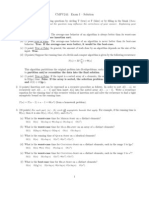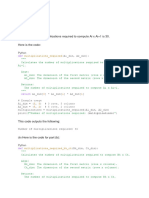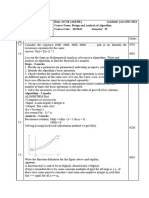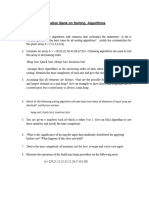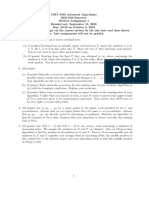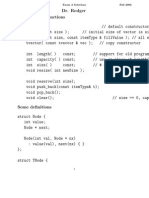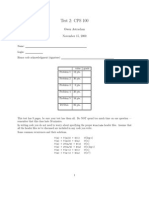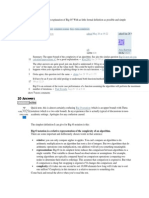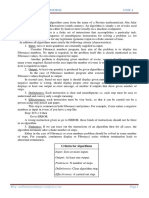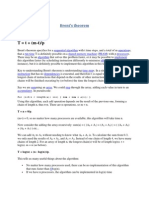Problem Set
Problem Set
Uploaded by
Gobara DhanCopyright:
Available Formats
Problem Set
Problem Set
Uploaded by
Gobara DhanOriginal Description:
Copyright
Available Formats
Share this document
Did you find this document useful?
Is this content inappropriate?
Copyright:
Available Formats
Problem Set
Problem Set
Uploaded by
Gobara DhanCopyright:
Available Formats
CSE3358 Problem Set 5 02/11/05 Due 02/18/05 Problem 1: Young tableau An m n Young tableau is an m n matrix such that the
he entries of each row are in sorted order from left to right and the entries of each column are in sorted order from top to bottom. Some of the entries of a Young tableau may be , which we treat as nonexistent elements. Thus a Young tableau can be used to hold r mn numbers. Heres an example of a 4x4 Young tableau containing the elements {9, 16, 3, 2, 4, 8, 5, 14, 12}. Note that this is not unique.
2 3 5 12 4 8 14 9 16
(a) (5 points) Argue that an m n Young tableau Y is empty if Y [1, 1] = . Argue that Y is full (contains mn elements) if Y [m, n] < . (b) (5 points) Argue that the minimum element of a Young tableau Y is always in Y [1, 1]. (c) (10 points) Give an algorithm to implement EXTRACT-MIN on a nonempty m n Young tableau that runs in O(m + n) time. Your algorithm should use a recursive subroutine that solves an m n problem by recursively solving either an (m 1) n or an m (n 1) subproblem. Dene T (p), where p = m + n, to be the maximum running time of EXTRACT-MIN on any m n Young tableau. Give and solve a recurrence for T (p) that yields the O(m + n) time bound. (d) (10 points) Show how to insert a new element into a nonfull m n Young tableau in O(m + n) time. (d) (10 points) Using no other sorting method as subroutine, show how to use an n n Young tableau to sort n2 numbers in O(n3 ) time. Based on this, describe a sorting algorithm that has an O(n1.5 ) worst-case running time. (e) (0 points) I will not ask: given n distinct elements, how many Young tableaus can you make?
Problem 2: Sometimes you just have to count (10 points) Describe an algorithm that, given n integers in the rangle 0 to k , preprocesses its input and then answers any query about how many of the n integers fall into a rangle [a..b] in O(1) time. Your algorithm should use (n + k ) prepreocessing time. For full credit you should Describe your algorithm in english Provide a pseudocode Provide arguments for the correctness of your algorithm Provide arguments for the running times of the preprocessing and the query operations Problem 3: S0rt1ing revisited Suppose that we have an array of n data records to sort and that the key of each record has the value 0 or 1. An algorithm for sorting such a set of records might possess some subset of the following three desirable properties: 1. The algorithm runs in O(n) time 2. The algorithm is stable 3. The algorithm sorts in place, using no more than a constant amount of storate space in addition to the original array (a) (5 points) Describe an algorithm that possesses properties (1) and (2). (b) (5 points) Describe an algorithm that possesses properties (2) and (3). (c) (10 points) Describe an algorithm that possesses properties (1) and (3). For full credit you should in each case: Describe your algorithm in english Provide a pseudocode, unless you are describing an algorithm for which we have seen the pseudocode in class Provide arguments that your algorithm possesses the desired properties
You might also like
- Algorithm Design and Applications: Instructor's Solutions ManualDocument10 pagesAlgorithm Design and Applications: Instructor's Solutions ManualCom Digful0% (1)
- Problem Set 1Document13 pagesProblem Set 1redNo ratings yet
- Exam SolDocument4 pagesExam SolgsandynitwNo ratings yet
- hw2 PDFDocument2 pageshw2 PDFAnonymous 7nsxsnNo ratings yet
- Linear RegressionDocument14 pagesLinear RegressionSaad AhmedNo ratings yet
- CM 339 CS 341 1101 Midterm - ExamDocument11 pagesCM 339 CS 341 1101 Midterm - ExamJohn SalazarNo ratings yet
- Fall 2010 - 91.503 - Algorithms - 2nd ExamDocument4 pagesFall 2010 - 91.503 - Algorithms - 2nd ExamankitxsNo ratings yet
- Midterm CS-435 Corazza Solutions Exam B: I. T /F - (14points) Below Are 7 True/false Questions. Mark Either T or F inDocument8 pagesMidterm CS-435 Corazza Solutions Exam B: I. T /F - (14points) Below Are 7 True/false Questions. Mark Either T or F inRomulo CostaNo ratings yet
- midterm1practiceDocument11 pagesmidterm1practicethandiwegreensNo ratings yet
- DSA Assignment 1-SolutionsDocument10 pagesDSA Assignment 1-SolutionsChatianya ChaniyaraNo ratings yet
- Tut Divide ProblemsDocument7 pagesTut Divide ProblemsTimothy KurbyNo ratings yet
- Exam ExamplesDocument15 pagesExam ExamplesAhmed MabrokNo ratings yet
- ps2Document3 pagesps2sunshiyao0No ratings yet
- MidsemDocument6 pagesMidsemAravind SomasundaramNo ratings yet
- S MidsolDocument3 pagesS MidsolSachin MichuNo ratings yet
- Mid-Sem RegularDocument2 pagesMid-Sem Regulararyankhare345No ratings yet
- Ada (Sem-5) NumericalsDocument7 pagesAda (Sem-5) Numericals22it085.bhavik.mejraniNo ratings yet
- HW 6Document9 pagesHW 6linguistduolingoNo ratings yet
- Practice Sheet Divide and ConquerDocument5 pagesPractice Sheet Divide and ConquerApoorva GuptaNo ratings yet
- COMP 171 Data Structures and Algorithms Spring 2005Document12 pagesCOMP 171 Data Structures and Algorithms Spring 2005Gobara DhanNo ratings yet
- HW1Document3 pagesHW1RafayGhafoorNo ratings yet
- CS510 ProblemSet 3 Divide N ConquerDocument5 pagesCS510 ProblemSet 3 Divide N ConquerAyush PatelNo ratings yet
- KslvhjkldsDocument8 pagesKslvhjkldsLouisNo ratings yet
- COMPSCI330 Design and Analysis of Algorithms Assignment 1: Due Date: Thursday, August 27, 2020Document2 pagesCOMPSCI330 Design and Analysis of Algorithms Assignment 1: Due Date: Thursday, August 27, 2020CanjiNo ratings yet
- Algorithms AssignmentDocument1 pageAlgorithms AssignmentSerene InNo ratings yet
- Test 1: CPS 100: Owen Astrachan October 1, 2004Document14 pagesTest 1: CPS 100: Owen Astrachan October 1, 2004Gobara DhanNo ratings yet
- ps1Document2 pagesps1sunshiyao0No ratings yet
- Exercises 1.2Document13 pagesExercises 1.2Mahdi HallakNo ratings yet
- HW2 MTH452/552Document7 pagesHW2 MTH452/552Jhovanny AlexanderNo ratings yet
- 18.314: Practice Hour Exam #1Document3 pages18.314: Practice Hour Exam #1Lionel CarlosNo ratings yet
- Previous Year Quest 1Document8 pagesPrevious Year Quest 1Aggarwal ShailjaNo ratings yet
- algoxy-enDocument376 pagesalgoxy-eniamkleptomaniac007No ratings yet
- 22CII42 CIE1 SchemeDocument3 pages22CII42 CIE1 Schemekpriya1122334455No ratings yet
- Samsung QP Data Struct SolutionDocument5 pagesSamsung QP Data Struct SolutionPiyush GoyalNo ratings yet
- COL106 Major SubjectiveDocument2 pagesCOL106 Major SubjectiveDevang SinghNo ratings yet
- 10910 計算方法設計 許健平 mid1Document6 pages10910 計算方法設計 許健平 mid1940984326No ratings yet
- Sheet-1Document2 pagesSheet-1Vishakha AgarwalNo ratings yet
- Lec 5Document5 pagesLec 5Sake AnilaNo ratings yet
- Question Bank on Sorting AlgorithmsDocument6 pagesQuestion Bank on Sorting Algorithmsdia.batra0704No ratings yet
- Assignment1 PDFDocument2 pagesAssignment1 PDFrineeth mNo ratings yet
- Ada Answers Simp M1,2,3Document33 pagesAda Answers Simp M1,2,3Akash PaulNo ratings yet
- Daa Unit IIDocument21 pagesDaa Unit IINikhil YasalapuNo ratings yet
- ExercisesDocument42 pagesExercisesyahiapcuserNo ratings yet
- Quiz 1: and Analysis of AlgorithmsDocument13 pagesQuiz 1: and Analysis of AlgorithmsajgeminiNo ratings yet
- National Institute of Technology RourkelaDocument2 pagesNational Institute of Technology RourkelaThanoj KumarNo ratings yet
- Exer4 W23Document3 pagesExer4 W23Queen liuNo ratings yet
- Algorithms ProblemsDocument2 pagesAlgorithms ProblemsRekha GovindarajNo ratings yet
- COL106 Problems PDFDocument10 pagesCOL106 Problems PDFgNo ratings yet
- Test 1 Review and Practice QuestionsDocument7 pagesTest 1 Review and Practice QuestionselsainetedelautrecNo ratings yet
- 2022 Spring CS300 MidtermDocument9 pages2022 Spring CS300 MidtermyunajessiNo ratings yet
- ADA Que Bank 2023-2024Document18 pagesADA Que Bank 2023-2024jackpatel56826No ratings yet
- CSCI 3110 Assignment 6 Solutions: December 5, 2012Document5 pagesCSCI 3110 Assignment 6 Solutions: December 5, 2012AdamNo ratings yet
- Dsa QDocument45 pagesDsa QB38 PRERANA.M.CNo ratings yet
- NumPySciPy WorksheetDocument3 pagesNumPySciPy Worksheetsiddhant bhandariNo ratings yet
- EECE 431 MidtermDocument3 pagesEECE 431 MidtermDan CarboNo ratings yet
- Assignment 2Document4 pagesAssignment 2DharneeshkarDandyNo ratings yet
- HW 1Document1 pageHW 1calvinlam12100No ratings yet
- Design and Analysis of Algorithms - Tutorial Sheet PracticeDocument2 pagesDesign and Analysis of Algorithms - Tutorial Sheet PracticeMIHIKA PARAG DESHPANDENo ratings yet
- Module 2Document7 pagesModule 2farispalayiNo ratings yet
- Matrices with MATLAB (Taken from "MATLAB for Beginners: A Gentle Approach")From EverandMatrices with MATLAB (Taken from "MATLAB for Beginners: A Gentle Approach")Rating: 3 out of 5 stars3/5 (4)
- CPS 100 J. Forbes Fall 2001 Test #2: PROBLEM 1: (Drawing (10 Points) )Document4 pagesCPS 100 J. Forbes Fall 2001 Test #2: PROBLEM 1: (Drawing (10 Points) )Gobara DhanNo ratings yet
- Function Module in SAPDocument11 pagesFunction Module in SAPGobara DhanNo ratings yet
- Test 2 Spring 01Document11 pagesTest 2 Spring 01Gobara DhanNo ratings yet
- Owen Astrachan and Dee Ramm November 19, 1996Document11 pagesOwen Astrachan and Dee Ramm November 19, 1996Gobara DhanNo ratings yet
- Test 2: Compsci 100: Owen Astrachan November 11, 2009Document9 pagesTest 2: Compsci 100: Owen Astrachan November 11, 2009Gobara DhanNo ratings yet
- Test 2: Compsci 100: Owen Astrachan November 12, 2008Document10 pagesTest 2: Compsci 100: Owen Astrachan November 12, 2008Gobara DhanNo ratings yet
- Test 2: Compsci 100: Owen Astrachan November 14, 2006Document17 pagesTest 2: Compsci 100: Owen Astrachan November 14, 2006Gobara DhanNo ratings yet
- Dr. Rodger Some Tvector FunctionsDocument18 pagesDr. Rodger Some Tvector FunctionsGobara DhanNo ratings yet
- Test 2: CPS 100: Owen Astrachan November 15, 2000Document9 pagesTest 2: CPS 100: Owen Astrachan November 15, 2000Gobara DhanNo ratings yet
- Test 1 Spring 98Document7 pagesTest 1 Spring 98Gobara DhanNo ratings yet
- Call Adobe Form Through ABAP Web DynproDocument47 pagesCall Adobe Form Through ABAP Web DynproGobara DhanNo ratings yet
- Test 1 Spring 97Document9 pagesTest 1 Spring 97Gobara DhanNo ratings yet
- Test 1 Spring 09Document17 pagesTest 1 Spring 09Gobara DhanNo ratings yet
- Test 1 Spring 95Document9 pagesTest 1 Spring 95Gobara DhanNo ratings yet
- Test 1 Spring 06Document11 pagesTest 1 Spring 06Gobara DhanNo ratings yet
- Test 1 Spring 04Document16 pagesTest 1 Spring 04Gobara DhanNo ratings yet
- Test 1 Spring 03Document15 pagesTest 1 Spring 03Gobara DhanNo ratings yet
- CPS 100, Ramm Hour Exam #1 (10/6/98) Fall, 1998Document8 pagesCPS 100, Ramm Hour Exam #1 (10/6/98) Fall, 1998Gobara DhanNo ratings yet
- Test 1 Fall 97Document8 pagesTest 1 Fall 97Gobara DhanNo ratings yet
- Alg PDFDocument6 pagesAlg PDFsahilmulani2003No ratings yet
- Daa BitsDocument44 pagesDaa Bitskirrudec26100% (1)
- Model MCQDocument23 pagesModel MCQRohan RaiNo ratings yet
- Vol 2 SepDocument701 pagesVol 2 Sepadityapankaj55No ratings yet
- Big oDocument21 pagesBig oPragati ChimangalaNo ratings yet
- Theory of Computation and ComplexityDocument21 pagesTheory of Computation and ComplexityStephanie ChuNo ratings yet
- Lectures On Computational Physics: Badis YdriDocument130 pagesLectures On Computational Physics: Badis YdriMaria CastilloNo ratings yet
- Time ComplexityDocument4 pagesTime ComplexityGëzim MusliajNo ratings yet
- Algorithm ContinuesDocument24 pagesAlgorithm ContinuesAdhara MukherjeeNo ratings yet
- Running Time Evaluation: Worst-Case and Average-Case PerformanceDocument27 pagesRunning Time Evaluation: Worst-Case and Average-Case PerformancePavan KumarNo ratings yet
- Space Complexity of AlgorithmsDocument2 pagesSpace Complexity of Algorithmsakash kurheNo ratings yet
- Design and Analysis of Algorithms - Question BankDocument18 pagesDesign and Analysis of Algorithms - Question BankMS.KIRUTHIKA VNo ratings yet
- DSA456 Midterm Dilli PDFDocument8 pagesDSA456 Midterm Dilli PDFnavneetkaur12482No ratings yet
- DsDocument27 pagesDsArpit GuptaNo ratings yet
- CSA06 Design and Analysis of Algorithms: Unit 1 - Tutorial 1Document53 pagesCSA06 Design and Analysis of Algorithms: Unit 1 - Tutorial 1rachelevelynr9007.sseNo ratings yet
- Data Structure PDFDocument233 pagesData Structure PDFSherNo ratings yet
- Quiz 1Document6 pagesQuiz 1asnhu19No ratings yet
- Lect 1 IntroDocument61 pagesLect 1 IntroMohamed AkelNo ratings yet
- Lecture 2Document21 pagesLecture 2Vishak VijayakumarNo ratings yet
- Stabbing Line SegmentDocument8 pagesStabbing Line SegmentsanjibNo ratings yet
- Session 7 (Algorithms)Document32 pagesSession 7 (Algorithms)LukaNo ratings yet
- Data Structures: Assist - Prof.Dr. Erkan TANYILDIZIDocument103 pagesData Structures: Assist - Prof.Dr. Erkan TANYILDIZIwircexdjNo ratings yet
- Algorithm:: Definition: An Algorithm Is A Finite Set of Instructions That Accomplishes A Particular TaskDocument76 pagesAlgorithm:: Definition: An Algorithm Is A Finite Set of Instructions That Accomplishes A Particular TaskGovada DhanaNo ratings yet
- Unit 1 Introduction To Data StructuresDocument31 pagesUnit 1 Introduction To Data StructuresAbhijit AbhangNo ratings yet
- Asymptotic Notation PDFDocument22 pagesAsymptotic Notation PDFRohulhuda AfghanNo ratings yet
- ELEE28706D AlgorithmAnalysis S3Document34 pagesELEE28706D AlgorithmAnalysis S3Ehtisham MalikNo ratings yet
- Tutorial 2Document4 pagesTutorial 2mrout0333No ratings yet
- Data Structures by Fareed Sem IV 27-Jan-2020 Pages 213 Completed W1Document213 pagesData Structures by Fareed Sem IV 27-Jan-2020 Pages 213 Completed W1Prasad S RNo ratings yet
- Brent TheoremDocument2 pagesBrent TheoremAvadhoot_JoshiNo ratings yet


